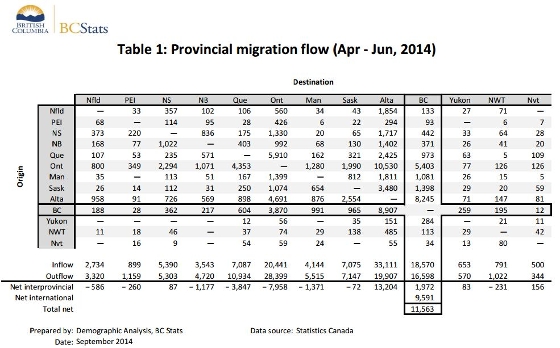Quarterly Population Highlights - BC and Canada
A release from the Province of British Columbia’s central statistical agency
REFERENCE DATE: JULY 1, 2014 | ISSUE #14-02
B.C. HIGHLIGHTS:
British Columbia’s population was estimated at 4,631,302 as of July 1, 2014, growing by 14,676 persons in the second quarter of 2014 (an increase of 0.3% compared to the first quarter of 2014). Combined net migration from all sources (interprovincial and international) was 11,563. Net interprovincial in-migration totalled 1,972 persons in this
quarter, an increase from the first quarter of 2014. Net international migration accounted for over 65% of the
second quarter gain. The other major component of population growth was a natural increase (births minus
deaths) of 3,113 which accounted for 21% of second quarter growth.
B.C. Population April 1, 2014 4,616,626
Interprovincial migration + 1,972
Add interprovincial arrivals + 18,570
Minus interprovincial exits − 16,598
International migration + 9,591
Add immigrants + 9,917
Minus total net emigrants − 2,414
Net change in non-permanent residents + 2,088
Natural increase + 3,113
Add births + 11,107
Minus deaths − 7,994
B.C. Population July 1, 2014 = 4,631,302
THE LAST TWELVE MONTHS:
B.C.’s total population increase over the twelve months ending July 1, 2014 was 48,677 persons (+1.1%), largely
due to international migration. Immigrants (+37,451) and non-permanent residents (+11,407) continue to be steady
providers of population growth for the province. Interprovincial migration accounted for a net gain of 2,267
persons from July 1, 2013 to July 1, 2014. Total net migration accounted for nearly 78% (+37,906) of the
population growth since July 1, 2013. The remainder was due to the natural increase (+22%; +10,771).
NATIONAL OVERVIEW:
The population of Canada grew by 124,240 persons (+0.35%) to 35,540,419 during the second quarter of 2014.
Leading the growth at the provincial and territorial level were Nunavut (+0.92%), Alberta (+0.86%), and Yukon (+0.79%) followed by Saskatchewan (+0.47%) and Manitoba (+0.43%). The population of British Columbia, Prince
Edward Island, Ontario, Quebec and Nova Scotia reported small gains. The remaining provinces and territories saw population declines.
SECOND QUARTER INTERNATIONAL MIGRATION:
Second quarter net international in-migration increased slightly from the previous quarter to 9,591 from 8,691. This is due mostly to fewer persons leaving for international destinations. More than nine thousand persons (+9,917) immigrated to British Columbia during the second quarter of 2014, offset by about 2,414 persons who emigrated. The net change in nonpermanent residents (NPRs) was +2,088 from April 1, 2014 to July 1, 2014.
SECOND QUARTER INTERPROVINCIAL MIGRATION:
British Columbia was one of five provinces that reported a net gain in population (+1,972) from other Canadian jurisdictions in the second quarter. In B.C. an inflow of 18,570 persons was offset by an outflow of 16,598. British Columbia’s net exchange with Alberta was negative with an estimated 662 more persons leaving B.C. for Alberta than coming to British Columbia. Conversely, net migration from Ontario (+1,533), Saskatchewan (+433) and Manitoba (+90) to B.C. was positive. Alberta was the biggest net recipient province in the second quarter of 2014 with a net gain of 13,204 persons, followed by B.C. with a net gain of 1,972. Nunavut, with a net inflow of 156 persons, Nova Scotia (+87) and Yukon (+83) were the only other areas to post a net gain in interprovincial migrants.








Comments:
Post Your Comment: